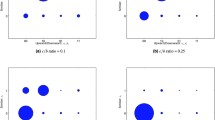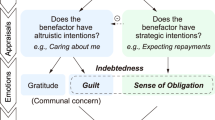Abstract
Recent research indicates that an interdisciplinary approach bridging the gap between social science and neuroscience is a key factor for obtaining a better understanding of individual decision making and social phenomena. This paper focuses on reciprocal fairness as a paradigmatic interdisciplinary case study. We discuss the recent behavioral evidence on reciprocity, identifying several unanswered questions. We then review the relevant neuroeconomic evidence about reciprocal preferences, mind reading and empathy.
Similar content being viewed by others
References
Alexander R (1987) The biology of moral systems. Aldine de Gruyter, New York
Andreoni J, Brown P, Vesterlund L (2002) What makes an allocation fair? Some experimental evidence. Games Econ Behav 40:1–24
Antonietti A, Iannello P (2011) Social sciences and neuroscience: a circular integration. Int Rev Econ 58(3). doi:10.1007/s12232-011-0132-y
Bacharach M, Guerra G, Zizzo D (2007) Is trust self-fulfilling? An experimental study. Theor Decis 63:349–388
Battigalli P, Dufwenberg M (2007) Guilt in games. Am Econ Rev Pap Proc 97:171–176
Bhatt M, Camerer C (2005) Self-referential thinking and equilibrium as state of mind in games: fMRI evidence. Games Econ Behav 52:424–459
Binmore K (1998) Game theory and the social contract, II: just playing. MIT Press, Cambridge
Blount S (1995) When social outcomes aren’t fair: The effect of causal attributions on preferences. Organ Behav Hum Decis Process 63:131–144
Bolton G, Brandts J, Ockenfels A (1998) Measuring motivations for the reciprocal responses observed in a simple dilemma game. Exp Econ 1:207–220
Bolton E, Brandts J, Ockenfels A (2005) Fair procedures: evidence from games involving lotteries. Econ J 115:1054–1076
Bolton G, Ockenfels A (2000) ERC—a theory of equity, reciprocity and competition. Am Econ Rev 90:166–193
Bolton G, Ockenfels A (2005) A stress test of fairness measures in models of social utility. Econ Theory 25:957–982
Bowles S, Gintis H (2004) The evolution of strong reciprocity: cooperation in heterogeneous populations. Theor Popul Biol 65:17–28
Brandts J, Solà C (2001) Reference points and negative reciprocity in simple sequential games. Games Econ Behav 36:138–157
Camerer C (2007) Neuroeconomics: using neuroscience to make economic predictions. Econ J 117(519):C26–C42
Camerer C, Loewenstein G, Prelec D (2005) Neuroeconomics: how neuroscience can inform economics. J Econ Lit 43(1):9–64
Charness G (2004) Attribution and reciprocity in a simulated labor market: an experimental investigation. J Labour Econ 22:665–688
Cronby J (2007) Integrating social science with neuroscience: potentials and problems. BioSocieties 2:149–169
De Quervain D, Fischbacher U, Treyer V, Schellhammer M, Schnyder U, Buck A, Fehr E (2004) The neural basis of altruistic punishment. Science 305:1254–58
Dufwenberg M, Gneezy U, Güth W, van Damme E (2001) Direct versus indirect reciprocity: an experiment. Homo Oeconomicus 18:19–30
Dufwenberg M, Kirchsteiger G (2004) A theory of sequential reciprocity. Games Econ Behav 47:268–298
Engelmann D, Fischbacher U (2009) Indirect reciprocity and strategic reputation building in an experimental helping game. Games Econ Behav 67(2):399–407
Falk A, Fehr E, Fischbacher U (2003) On the nature of fair behaviour. Econ Inq 41:20–26
Falk A, Fischbacher U (2006) A theory of reciprocity. Games Econ Behav 54:293–315
Falk A, Fehr E, Fischbacher U (2008) Testing theories of fairness—Intentions matter. Games Econ Behav 62:287–303
Fehr E, Camerer C (2007) Social neuroeconomics: the neural circuitry of social preferences. Trends Cogn Sci 11(10):419–427
Fehr E, Fischbacher U, Kosfeld U (2005) Neuroeconomic foundations of trust and social preferences: initial evidence. Am Econ Rev 95:346–351
Fehr E, Gächter S (2000) Fairness and retaliation—the economics of reciprocity. J Econ Perspect 14(3):159–181
Fehr E, Gächter S (2002) Altruistic punishment in humans. Nature 415:137–140
Fehr E, Schmidt K (1999) A theory of fairness, competition, and cooperation. Q J Econ 114:817–868
Fehr E, Schmidt M (2006) The Economics of Fairness, Reciprocity and Altruism: Experimental Evidence. In: Kolm SC, Ythier JM (eds) Handbook of the Economics of Giving, Altruism and Reciprocity, vol 1. Elsevier, Amsterdam, pp 615–691
Frith U, Frith C (2003) Development and neurophysiology of mentalizing. Philos Trans R Soc Lond B Biol Sci 358:459–473
Gallagher H, Jack A, Roepstorff A, Frith C (2002) Imaging the intentional stance in a competitive game. NeuroImage 16:814–821
Gallagher H, Frith C (2003) Functional imaging of ’theory of mind’. Trends Cogn Sci 7(2):77–83
Gallese V, Goldman A (1998) Mirror neurons and the simulation theory of mindreading. Trends Cogn Sci 2:493–501
Gintis H (2000) Strong reciprocity and human sociality. J Theor Biol 206:169–179
Greiner B, Levati M (2005) Indirect reciprocity in cyclical networks: an experimental study. J Econ Psychol 26(5):711–731
Guth W, Konigstein M, Marchand N, Nehring K (2001) Trust and reciprocity in the investment game with indirect reward. Homo Oeconomicus 18:241–262
Hamilton W (1964) Genetical evolution of social behavior. J Theor Biol 7(1):1–52
Jackson P, Meltzoff A, Decety J (2005) How do we perceive the pain of others: a window into the neural processes involved in empathy. Neuroimage 24(3):771–9
Jevons W (1871) The theory of political economy. Macmillan and Co, London
Keysers C, Wicker B, Gazzola V, Anton J, Fogassi L, Gallese V (2004) A touching sight: SII/PV activation during the observation and experience of touch. Neuron 42(2):335–346
Knoch D, Fehr E (2007) Resisting the power of temptations: the right prefrontal cortex and self-control. Ann NY Acad Sci 1104:123–134
Knoch D, Pascual-Leone A, Meyer K, Treyer V, Fehr E (2006a) Diminishing reciprocal fairness by disrupting the right prefrontal cortex. Science 314(5800):829–32
Knoch D, Gianotti L, Pascual-Leone A, Treyer V, Regard M, Hohmann M, Brugger P (2006b) Disruption of right prefrontal cortex by low-frequency repetitive transcranial magnetic stimulation induces risk-taking behavior. J Neurosci 26:6469–6472
Knoch D, Nitsche M, Fischbacher U, Eisenegger C, Pascual-Leone A, Fehr E (2008) Studying the neurobiology of social interaction with transcranial direct current stimulation—the example of punishing unfairness. Cereb Cortex 18(9):1987–1990
Knoch D, Schneiderb F, Schunkb D, Hohmann M, Fehr E (2009) Disrupting the prefrontal cortex diminishes the human ability to build a good reputation. PNAS 106(49):20895–20899
Leimar O, Hammerstein P (2001) Evolution of cooperation through indirect reciprocity. Proc Roy Soc Biol Sci 268:745–753
Levine D (2011) Neuroeconomics? Int Rev Econ 58(3). doi:10.1007/s12232-011-0128-7
McCabe K, Houser D, Ryan L, Smith V, Trouard T (2001) A functional imaging study of cooperation in two-person reciprocal exchange. Proc Natl Acad Sci USA 98(20):11832–11835
McCabe K, Rigdon M, Smith V (2003) Positive reciprocity and intentions in trust games. J Econ Behav Org 52:267–275
Nowak M, Sigmund K (1998) The dynamics of indirect reciprocity. J Theor Biol 194:561–574
Nowak M, Sigmund K (2005) Evolution of indirect reciprocity. Nature 437(27):1291–1298
Offerman T (2002) Hurting hurts more that helping helps. Eur Econ Rev 46:1423–1437
Pelligra V (2011) Empathy, guilt-aversion, and patterns of reciprocity. J Neurosci Psychol Econ (in press)
Preston S, de Waal F (2002) Empathy: its ultimate and proximate bases. Behav Brain Sci 25(1):1–72
Rabin M (1993) Incorporating fairness into game theory and economics. Am Econ Rev 83:1281–1302
Ridley M (1996) The origins of virtue: human instincts and the evolution of cooperation. Penguin Books Ltd, London
Rilling J, Gutman D, Zeh T, Pagnoni G, Berns G, Kilts C (2002) A neural basis for social cooperation. Neuron 35:395–405
Rilling J, Sanfey G, Aronson A, Nystrom E, Cohen J (2004) Opposing BOLD responses to reciprocated and unreciprocated altruism in putative reward pathways. Neuroreport 15:2539–2543
Rizzolatti G, Fadiga L, Gallese V, Fogassi L (1996) Premotor cortex and the recognition of motor actions. Brain Res Cogn Brain Res 3(2):131–141
Rizzolatti G, Fogassi L, Gallese V (2001) Neurophysiological mechanisms underlying the understanding and imitation of action. Nat Rev Neurosci 2:661–670
Sanfey A, Rilling J, Aronson J, Nystrom L, Cohen J (2003) The neural basis of economic decision-making in the ultimatum game. Science 300:1755–1758
Sanfey A, Loewenstein G, Cohen J, Mcclure S (2006) Neuroeconomics: cross-currents in research on decision. Trends Cogn Sci 10:108–116
Seinen I, Schram A (2006) Social status and group norms: indirect reciprocity in a repeated helping experiment. Eur Econ Rev 50(3):581–602
Shinsuke S, Kazuhisa N, Syoken F, Eizo A (2011) Neural basis of conditional cooperation. Soc Cogn Affect Neurosci 6(3):338–347
Singer T (2009) Understanding others: brain mechanisms of theory of mind and empathy. In: Paul WG, Colin FC, Ernst F, Russell AP (eds) Neuroeconomics: decision making and the brain. Academic Press, London, pp 251–268
Singer T, Fehr E (2005) The neuroeconomics of mind reading and empathy. Am Econ Rev 95(2):340–345
Singer T, Kiebel S, Winston J, Dolan R, Frith C (2004) Brain responses to the acquired moral status of faces. Neuron 41(4):653–662
Singer T, Seymour B, O’Doherty J, Stephan K, Dolan R, Frith C (2006) Empathic neural responses are modulated by the perceived fairness of others. Nature 439:466–469
Sobel J (2005) Interdependent preferences and reciprocity. J Econ Lit 43:392–436
Stanca L (2009) Measuring indirect reciprocity: whose back do we scratch? J Econ Psychol 30(2):190–202
Stanca L (2010) How to be kind? Outcomes versus intentions as determinants of fairness. Econ Lett 106(1):19–21
Stanca L, Bruni L, Corazzini L (2009) Testing theories of reciprocity: do motivations matter? J Econ Behav Org 71(2):233–245
Stanca L, Bruni L, Mantovani M (2011) The effect of motivations on social indirect reciprocity: an experimental analysis. Appl Econ Lett (in press). doi:10.1080/13504851.2011.560105
Tabibnia G, Satpute A, Lieberman M (2008) The sunny side of fairness: preference for fairness activates reward circuitry (and disregarding unfairness activates self-control circuitry). Psychol Sci 19(4):339–347
Trivers R (1971) The evolution of reciprocal alruism. Q Rev Biol 46:35–57
Umiltà C (2011) Can cognitive neuroscience give rise to satellite disciplines, such as neuro-economics? Int Rev Econ 58(3). doi:10.1007/s12232-011-0129-6
Viale R (2011) Brain reading social action. Int Rev Econ 58(3). doi:10.1007/s12232-011-0130-0
Vromen J (2011) Neuroeconomics: two camps gradually converging: what can economics gain from it? Int Rev Econ 58(3). doi:10.1007/s12232-011-0127-8
Wedekind C, Milinski M (2000) Cooperation through image scoring in humans. Science 288:850–852
Wicker B, Keysers C, Plailly J, Royet JP, Gallese V, Rizzolatti G (2003) Both of us disgusted in my insula: the common neural basis of seeing and feeling disgust. Neuron 40:655–664
Author information
Authors and Affiliations
Corresponding author
Rights and permissions
About this article
Cite this article
Stanca, L. Social science and neuroscience: how can they inform each other?. Int Rev Econ 58, 243–256 (2011). https://doi.org/10.1007/s12232-011-0133-x
Received:
Accepted:
Published:
Issue Date:
DOI: https://doi.org/10.1007/s12232-011-0133-x




